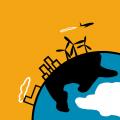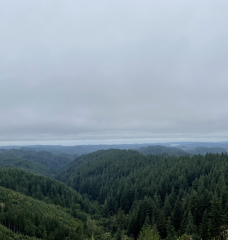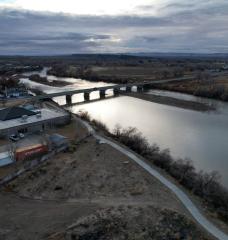Description
Listen on your favorite streaming app.
Roughly ten percent of the world’s CO2 emissions come from passenger vehicles: cars, pickups, motorcycles, buses, and taxis. So today, we’re going to zoom in on how people across the world get around every day, how that’s quickly changing, and what to consider when thinking about reducing carbon emissions from everyday travel. For this episode, we sat down with our former MIT colleague and transportation expert Dr. Joanna Moody.
Dr. Joanna Moody is a Researcher in the Transport Global Knowledge and Expertise Unit at the World Bank. She was previously the Research Program Manager for the MIT Energy Initiative's Mobility Systems Center: an industry-funded research consortium focused on the interaction between passenger and goods mobility, energy consumption, and climate change. Her research explores how travelers interact with technologies and policies, with a focus on how attitudes and social norms can shape more sustainable travel behavior. Dr. Moody received a Masters of Science in Transportation degree at MIT in 2016 and a PhD at MIT in 2019.
For more episodes of TILclimate by the MIT Environmental Solutions Initiative, visit tilclimate.mit.edu. To receive notifications about new episodes, follow us on Twitter @tilclimate.
Credits
- Laur Hesse Fisher, Host and Producer
- David Lishansky, Editor and Producer
- Aaron Krol, Associate Producer
- Barrett Golding, Script Writer
- Ilana Hirschfeld, Production Assistant
- Sylvia Scharf, Education Specialist
- Michelle Harris, Fact Checker
- Music by Blue Dot Sessions
- Artwork by Aaron Krol
Transcript
Laur Hesse Fisher: Hi, and welcome to Today I Learned: Climate. I’m your host Laur Hesse Fisher from the MIT Environmental Solutions Initiative.
Transportation is a big topic. It can include cars, trains, buses, planes, ships that cross the ocean, and trucks that cross the country. We have an episode on planes that we did in our first season, if you’re interested in that topic. Today, we’re going to narrow in on how people get around their cities and towns every day. Around 10% of the world’s CO2 emissions come from vehicles that carry people: cars, pickup trucks, motorcycles, buses, and taxis.
Joanna Moody: My name is Joanna Moody and I am a consultant with the World Bank's Transport Global Knowledge Unit. And I worked with the MIT Energy Initiative for their mobility systems center research, connecting transportation with energy consumption and climate change.
People don't usually travel for the sake of traveling. They travel because they are trying to get to a specific destination. They're heading to a job. They're getting healthcare or goods for their household.And so how do we get everyone where they need to go in as sustainable and low carbon a way as we can?
LHF: That’s our big question for today. Let’s jump in. First, how we tackle this problem differs significantly depending on where we’re tackling it.
JM: Over the past decade, what we've seen, is that transportation has only continued to increase in emissions. In the US in recent years, the transport sector overtook the energy sector as the highest emitting sector of the economy. And we're seeing similar trends in countries in the EU.
In developing countries currently their transport emissions are not very high, but as they continue to grow economically, if they motorize like the US and the EU, their transport emissions will grow increase.
LHF: Yeah, in developing countries, most people don’t drive cars – they walk, bike, use taxis, scooters, buses. In China, less than 10% of people own cars. Compare that to the U.S., where more than 90% of American households own a car.
But here’s the big thing: China have about 4 times as many people as the U.S. does. Over the past two decades, China's transportation emissions have increased four-times over. These things have actually put China as the second largest total emitter in the transportation sector – right behind the U.S.
JM: We are working on a global problem. And we will not meet our global goals for climate, unless we really address both the rapid growth in developing countries of transport emissions and the current high levels of transport emissions in developed countries. And those are two related, but different challenges.
When we start to think about developing countries, we're not only facing the challenge of trying to make the current travel low carbon, we're facing the challenge of how do we enable more travel because people aren't able to get to jobs; to education; to healthcare.
I'll give an anecdotal example: In Mexico city, low income residents often live very outside of the city center. To get to a job, they often need to travel for close to two hours in one direction. This often involves multiple different buses and transfers, long distances where they're forced to walk. And it is no wonder that as soon as that household, that individual is able to afford a car, they would buy one.
LHF: The U.S. Department of Energy’s data analysis agency forecasts that developing countries will have double the number of passenger vehicles by 2040. If things keep going the way they’re going, most will be gas-powered. If we want to slow down carbon emissions, this makes now an important time for change.
JM: And so the opportunity that we have in developing countries is that they have the foundations for sustainable travel, in that people are willing to walk, they're willing to take public transit, but they shouldn't be forced to do it in poor conditions.
LHF: There isn’t one right way to build low-carbon transportation – the city layout, geography, culture vary so much from city to city that what works well in one place might not in another. But there have been a few low-carbon transportation success stories that have made big news, like what the city of Bogota did in the South American country of Colombia.
JM: Bogata implemented one of the first bus rapid transit systems called TransMilenio. It's a system that has dedicated bus lanes that are free from traffic. And they often have much higher quality station infrastructure, akin to a train station.
LHF: Every day, over 30 million passengers in nearly 200 cities ride a bus rapid system. These bus systems have the capacity and speed of subways and other rapid transit, but without the huge infrastructure costs.
JM: And really their innovation was to say, I'm gonna prioritize the bus over other traffic because the bus is the most space and environmentally efficient, and also the most socially sustainable form of transport on a road.
A bus rapid transit system is a good potential option among a family of good transport options. Really, really good transit systems work for people and people want to take them.
But if we can't improve those systems to be competitive with a car then what we are going to see is that they're going to follow the more car oriented and high carbon patterns that we've seen in developed countries.
LHF: And when it comes to reducing emissions in the U.S. and other developed countries, it’s a totally different story.
JM: The reality in the US today is that we have — as a government, as taxpayers — paid for the construction of an entire interstate highway system and all of the roads that, um, exist on the ground.
Over 90% of households own a car. And that is the primary mode of transportation for most Americans. The real low-hanging fruit is electric vehicles. We can use green electricity to power the cars without hugely significant changes to the lifestyles that we already have. Moving to electric vehicles in the US will solve a significant portion of emissions.
LHF: I wasn’t expecting Dr. Moody to share this – when I think about cars and climate change, there’s such a narrative around getting out of cars – biking, walking, taking public transportation.
JM: There's a lot of talk about, uh, nudging people to take different travel modes, providing different pricing incentives. The real answer here is that those do help people who maybe are close to taking the transit or walking and biking, but they don't really impact the broader choice set.
That doesn't mean that we shouldn't also embrace and continue to invest in alternatives to the car where they make sense.What really impacts travel behavior is the quality of options. If I have a bus line that runs every 50 minutes or an hour, that's really not a particularly meaningful service for me. Now, if that bus were every 10 minutes, my choice becomes very, very different.
LHF: Public transportation — trains, buses, that sort of thing — reduces greenhouse gas emissions, both by taking people out of cars and by encouraging developers to locate workplaces and shopping areas near where people live. The difference is measurable. The National Academies of Sciences measured it: In 2018 for just the United States, public transportation helped avoid over 100 billion miles of car traffic: That's the equivalent of shutting 16 coal power plants for a year, even when accounting for the CO2 emitted by the trains and buses.
JM: I think the internationally recognized stories of really what is a success is gonna be in London in the UK, where the mayor made a decision to impose a congestion price in the center of the city, where you had to pay additional money to drive your car.
The way that London implemented this was to say the money that we collect from that congestion price is invested directly into the public transit services that are gonna serve that zone.
It wasn't just about, we're gonna make it more expensive to use a car, but it was also, we're gonna make it more attractive to use the alternative.
And something close to my heart is that they also recognize the importance of their Double Decker bus. They connected and they created a social norm around taking public transit that was part of the identity of being a Londoner.
And it has helped London to continue to invest in their transport system, for example, launching one of the largest new urban rail underground investments in the world, which is Crossrail, their new line.
LHF: Large-scale projects like these take time, often a decade if not more. And the global climate goal is to cut carbon emissions in half by 2030 and, twenty years later, to add no more carbon emissions than the planet can absorb.
JM: Transport infrastructure is long lived. The types of mobility systems that we invest in, the types of cities that we develop — they are gonna determine what those transportation emissions look like for the next 15 years.
In cities, the most valuable thing is public space. And roads take up a very large amount of our public space in cities. It's also where most municipal governments have some control.
You take one lane and you say, instead of this being a lane for cars, this is gonna be a lane only for buses. What you've just done is improved the quality of the bus service significantly.
You may also want to create bike lanes. When you start to get into suburban environments, you can create pockets of this, but on a smaller scale. And so you'll often have a small town center. Maybe that town center is connected to a larger city by a commuter rail system, and you could use that transit hub as an opportunity to build out a smaller pocket of walkable bikeable neighborhoods.
And that doesn't mean that cars shouldn't be one of the many road users, but they shouldn't be prioritized as the only road user. Allocating our space on our streets better is a low-cost, near-term, within-our-jurisdiction way of really starting to change our different travel modes, to the most sustainable, the most socially responsible choice.
LHF: That’s our episode for today, please rate us and write us a review on Apple podcasts, or wherever you’re listening from today, these reviews give us a boost and help other people hear about the show.
As always, we have an accompanying educator guide to help teach about these topics in middle and high school classrooms. You can find it at climate.mit.edu/educators. Or for free on the popular site, Teachers Pay Teachers.
TILclimate is produced by the MIT Environmental Solutions Initiative at the Massachusetts Institute of Technology. David Lishansky is our Editor and Producer. Aaron Krol is our Associate Producer — and did our artwork, Ilana Hirschfeld our Production Assistant, and Barrett Golding our Scriptwriter. Michelle Harris is our fact-checker. Sylvia Scharf is our Climate Education Specialist. The music is by Blue Dot Sessions. And I’m your Host and Producer, Laur Hesse Fisher.
A big thanks to Dr. Joanna Moody for speaking with us, and thank you for listening.
Dive Deeper
- To read more about Dr. Moody, visit: https://blogs.worldbank.org/team/joanna-moody
- Roughly ten percent of the world’s CO2 emissions come from passenger vehicles: cars, pickups, motorcycles, buses, and taxis. For a breakdown of GHG emissions from transportation, visit: https://ourworldindata.org/co2-emissions-from-transport
- In the U.S. and other developed nations, emissions from transportation have overtaken electricity as the largest contributor of GHG emissions. The U.S. EPA breaks down GHG emissions by sector: https://www.epa.gov/ghgemissions/sources-greenhouse-gas-emissions
- The MIT Energy Initiative’s three-year Mobility of the Future study explores the major factors that affect the evolution of personal mobility from 2020 to 2050. Read the report here: https://energy-mit-edu.ezproxy.canberra.edu.au/research/mobilityofthefuture/
- Bus Rapid Transit (BRT) is one form of transit that has proven effective around the world. Read about Bogotá, Colombia and its BRT success story: https://use.metropolis.org/case-studies/transmilenio-bus-rapid-transit-system
- Providing people with high quality transit alternatives to the car is one strategy that can help cities reduce their GHG emissions. This report from the National Academies of Sciences explores how cities are advancing public transportation as a significant part of their climate action strategies.
- For an overview of climate change, check out our climate primer: Climate Science and Climate Risk (by Prof. Kerry Emanuel and the MIT Environmental Solutions Initiative).
- Our educator guides that go along with each of our episodes make it easier to teach climate change, earth science, and energy topics in the classroom. Take a look at our newest educator guide on mobility.
- For more episodes of TILclimate by the MIT Environmental Solutions Initiative, visit tilclimate.mit.edu.
We fact-check our episodes. Click here to download our list of sources.
Educator Guide
The future of transportation includes multiple modes and ways of thinking about how we get around. Students learn about Complete Streets, tackle urban street design, and design their own transit system for an imaginary city.






